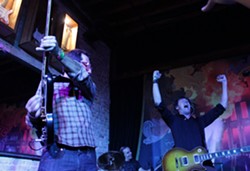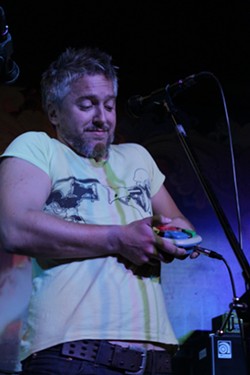Two-time Latin Grammy winner El Cuarteto de Nos. (All photos by Guillermina Zabala)
Here's my quick take on the March 13 Sounds of Uruguay showcase at Speakeasy:
Daniel "Tatita" Márquez
Tatita Márquez is the lonely young king of Afro-Uruguayan candombe, the southernmost Afro-Latin rhythm in the world. It is a syncopated rhythm played with three drums: the piano (the bass drum, which serves as the rhythm's heartbeat), the chico (the unchanging rhythmic pendulum that keeps the whole thing together), and the repique (which improvises over the other two). Working independently from the purist candombe mainstream, he has been doing his own thing for the last few years, mixing candombe with electronica, dance, hip-hop, and jazz. After his Haribol album, the initiated Hare Krishna devotee started a candombe/jazz project named Mukunda ("He who bestows liberation," one of Krishna's names), and quickly became the hottest Uruguayan percussionist (he's one of two percussionists in Jaime Roos' band, the most influential Uruguayan musician since the late '70s). At SXSW, he had to open the show, and the usually calm Tatita (calm as in "Om") didn't mind showing his displeasure for not being able to do proper soundcheck. When told he had four minutes left, he went rogue and kept on playing for almost 10. He had to be convinced to stop, and after a couple of hours he explained his refusal to abide by the rules of engagement. "If I hadn't done that, everybody's set would've been shortened," he said. "I was the first act and had to set the tone. You have some Grammy-nominated and Grammy-winning people here that deserve respect. You saw how calm Malena [Muyala's] and everybody else's band played after myself. But I had to stop [impatient sound people] on their tracks." Tatita (who plays the repique drum) shared the stage with Enrique "Papo" Guzmán on the piano and Leo Giovannini on the chico. Their starting point was candombe, but they took it everywhere, showing power, precision, and a lethal ability to exploit the rhythm's war-like darkness to the max. Less effective was Tatita's solo set, during which he played all three drums by himself over derivative prerecorded dance tracks. While their collective percussion-only section was original and groovy, Tatita's solo disco-friendly set was the type of stuff any second-rate African or Caribbean drummer (the type you find in every corner of the U.S.) could've done (minus the candombe part, that is). Completely needless and distracting, and I sincerely hope Tatita snaps out of it, for the simple reason he doesn't need it. The three came back at the end of Campo's set, which was the night's highest point. But I'll get back to that later. Malena Muyala Somehow, tango/milonga/milongón singer Malena Muyala and her band managed to be the only ones who were allowed to do proper soundcheck, and it paid off: their set was the most polished from beginning to end. My favorite moment was her rendition of Carlos Gardel's "Guitarra, guitarra mía" ("Guitar, guitar of mine"), an old classic from the early 1900s. Besides being a superb singer, she's also an underrated composer. The following gem is (at least in my book) one of the great Uruguayan popular songs ever. It is an existential milongón played in candombe time that talks about how we go through life gradually losing everything except our appetite for grooving. Franny Glass I would've preferred a more left-field repertoire by Franny Glass instead of the more accessible folk/pop-based selection he chose. Don't get me wrong: him and his band were solid, but I found their set a little misleading. To those who haven't heard his music (especially his latest, the excellent El podador primaveral, available on iTunes), he gave the impression of being an alternative folk singer-songwriter, but he's much more than that. His late, subtle explorations into candombe and murga (the black/white Uruguayan rhythmic yin/yang), heard in his music through his guitar rather than percussion (as in in the murga-flavored "Los daños"), where virtually untouched at SXSW. It was a fine set, but lacked a little fire. Nevertheless, my opinion of him hasn't changed: he's one of the most promising and original young Uruguayan talents. Campo Here's where the shit hit the speakers. If there was a band that needed to do some serious soundcheck, it was Campo. The band led by Juan Campodónico (lead guitarist for Bajofondo and producer of Oscar-winning Jorge Drexler and El Cuarteto de Nos) and which also includes fellow bajofonderos Verónica Loza and Gabriel Casacuberta, suffered from early feedback, weak vocal lead by Campo himself, and a hesitant Verónica Loza (usually a fine singer that deserves more time at the mic both in Campo and Bajofondo). While the original vocals of "La Marcha Tropical" and "1987" (sung on the self-titled Grammy-nominated album by Swedish singer Ellen Arkbro and Drexler, respectively) couldn't be replicated and only Martín Rivero was able to sing almost as well as he did in the album. Gradually, Campo solved the sound problems and, by the end of their set, their cumbia/electronica/hip-hop/candombe machine was in full force. They ended their set with "Heartbreak," at the end of which they called Tatita and his drums for a show-stopping moment that was the night's highest point. Martín Buscaglia Another victim of occasional feedback, in spite of technical difficulties Buscaglia was game — literally. His one-man orchestra set was a mix of guitar, bass, vocals (he "played" candombe's three different drums a capella), looping pedals and even a Simon Says controller. He records and plays regularly with a full band, but when he goes solo this is what it looks and sounds like. He pulled it off because he's an accomplished performer, but his set would've been more powerful had somebody (either at SXSW or in Uruguay's government) given a damn about how these guys sounded. Max Capote Nominated to a 2011 Latin Grammy as Best New Artist, Max Capote started as a novelty act that has showed unexpected success and longevity. Equal parts bandleader and performance artist, his blend of '50s and '60s rock ’n' roll, bolero, and salsa was at the center of one of the night's highlights: he started serenading an old guy with a long white beard, jumped on his table, and ended up walking and singing among the crowd, always glass in hand. The absurdness of it all made complete sense thanks to a dynamite band led by lead guitarist Leroy Machado, who would go from The Doors' "L.A. Woman" flashes to Chuck Berry's duck walk and back to a bolero without missing a beat. Billboard is right: Capote is the kind of guy you must see live before you die. El Cuarteto de Nos Ironically, the only band that reportedly brought not one, but two soundmen was the one that sounded the worse (if you're curious to know what the above song sounds like, click here). Fresh off winning Best Pop/Rock Album and Best Rock Song at the 2012 Latin Grammy, the Cuarteto (they're actually five) is a hook machine and arguably the best rock lyricists in the Spanish world. Their sarcastic, absurd, existential humor requires close attention to their long lyrics, which was virtually impossible to do because of, perhaps, their sound engineers' inability to communicate with the house sound guy (or the latter's unwillingness to listen). Nevertheless, the Cuarteto was greeted by an enthusiastic mosh pit of fans from El Salvador, Peru, Argentina, Venezuela and Mexico that knew every single word and made sure their set was a proper night-ending party.




